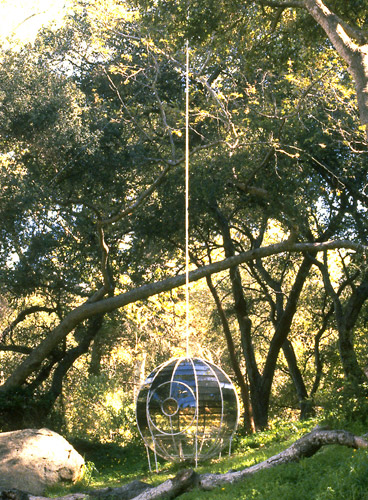Oculus:
Emerson/Beebe No. 1 & 2, originally known as Oculus:
Emerson/Beebe (Seas of Salt/Chains of Carbon), was commissioned
by Betty Klausner, director of the Santa Barbara Contemporary
Arts Forum, for the exhibition, "Eco Systems," 1989.
This work had two primary inspirations: first, the transcendentalist
philosophy of Ralph W. Emerson and his concept of an all seeing,
transparent eyeball in the essay Nature1 and
second, to the the bathysphere, a seminal deep sea diving apparatus
invented by
William Beebe, in the 1930's. Beebe descended more than 1/2
mile into the ocean, a first for his time. Oculus: Emerson/Beebe
No. 1 was installed inside the Contemporary Arts Forum,
filled with a circulating and continual mist of Pacific Ocean
sea water,
as its "vitreous humor." Oculus: Emerson/Beebe,
No. 2, was installed outdoors at the Santa Barbara Museum
of Natual History, lined with carbon soot from the ignition
of a hydrocarbon
solvent. Both Oculus: Emerson/Beebe, No. 1 & 2 are
oriented in the exhibition to look westward at the off-shore
oil drilling
platforms in the Pacific Ocean, metaphorically bringing Emerson
and Beebe into the present to examine and contemplate extrapolations
of their wisdom/explorations in the use of the environment.
For this and the pre-exhibition at Fuller Goldeen Gallery,
San Francisco, Ca, two drawings, each 6 ft. x 6 ft. of inverted
sea images: a sinking ship and an underwater canyon with oil
drill-rig poles penetrating through the sea were shown as visions
of the two oculi.
1Standing on the bare ground, --my head bathed by the blithe
air, and uplifted into infinite space, -- all mean egotism
vanishes. I become a transparent eyeball; I am nothing; I see
all; the
currents of the Universal Being circulating through me; I am
part or particle of God.
Ralph Waldo Emerson, Nature, 1836.
After "Eco-Systems," the physical apparatus of Oculus:
Emerson/Beebe No. 1, had numerous subsequent incarnations and
titles, resulting from alterations of context and/or of the
type of water comprising its "vitreous humor." Oculus:
Emerson/Beebe, No. 2 was not shown again after "Eco-Systems."
|
Oculus
Exhibition History:
Solo exhibition,
Fuller Goldeen Gallery, San Francisco, 1989, a pre-showing
of
the un-animated Oculus: Emerson/Beebee No. 1 & 2 apparatus/structures
and drawings before being tranported to Santa Barbara for "Eco-Systems." A
show of Pat Steir paintings were in the other gallery spaces.
Eco-Systems, Oculus: Emerson/Beebee No. 1 & 2, Santa Barbara
Contemporary Forum Santa Barbara, CA 1989.
The Nature of Materials, group exhibition, Lance Fung Gallery,
New York, NY,
1996 as Oculus: Emerson/Beebe, No. 1, with a "vitreous humor" of
Pacific Ocean water, shipped to the east coast.
The Rising Sea: Images and Constructions from South Florida and Other Selected
Works, solo exhibition, Museum of Contemporary Art, Lake Worth, FL, 1998, as
Oculus: Emerson/Beebe (de Leon/Osceola), 1998.
It "vitreous humor" was
black water from the Loxahatchee River, FL. This version extends the issues
of perception and the sublime into the Florida landscape through references
to Ponce
de Leon and the Seminole chief Osceola and the use of materials from the
Florida terrain.
Permanent collection, de Rosa Preserve, Napa County, CA as,
Oculus: Emerson/Beebe
(Sonomia), 2000. This is the final site for "No. 1," with
water from the aquifers of the Pliocene Sonoma Volcanics, also known for
its use
in Napa
Valley wines as its "vitreous humor." Alternating periods of misting
and drying are intended to build up a residue on the
interior surface as a symbolic distallation of the Napa/Sonoma landscape
and aquifer system in the form of deposited salts.
Oculus: Emerson/Beebee No. 1 & 2, formed the inspiration for a two-bathysphere/oculus
kiln project, Oculus: Dead Sea/Oil
Field, 1989, in Arvada, CO. The Arvada piece
also included two main ocular elements, Virgin Bathysphere and Ancient Bathysphere,
fired in a one-evening performance.
|

